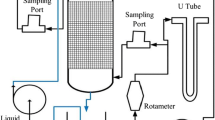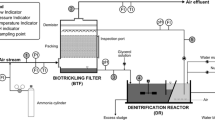Abstract
The paper presents the experimental results on a biotrickling pilot plant, with a water scrubber as pre-treatment, finalized to the treatment of an airborne toluene stream in a working place. The air stream was characterized by a very high variability of the inlet concentrations of toluene (range: 4.35–68.20 mg Nm−3) with an average concentrations of 16.41 mg Nm−3. The pilot plant has proved its effectiveness in toluene removal, along a 90-day experimentation period, in steady-state conditions. The scrubbing pre-treatment has achieved an average removal efficiency of 69.9 %, but in particular it has proven its suitability in the rough removal of the toluene peak concentrations, allowing a great stability to the following biological process. The biotrickling stage has achieved an additional average removal efficiency of 75.6 %, confirming the good biodegradability of toluene. The biofilm observation by a scanning confocal laser microscope has evidenced a biofilm thickness of 650 μm fully penetrated by toluene degrading bacteria. Among the micro-population Pseudomonas putida resulted the dominant specie. This bacterium can therefore be considered the responsible for most of the toluene degradation. The whole experimented process has determined an average 92.7 % for toluene removal efficiency. This result meets the most stringent limits and recommendations for occupational safety, given by authoritative organizations in the USA and EU; it also meets the odorous threshold concentration of 11.1 mg Nm−3.






Similar content being viewed by others
References
Amoore JE, Hautala E (1983) Odor as an aid to chemical safety: odor thresholds compared with threshold limit values and volatilities for 214 industrial chemicals in air and water dilution. J Appl Toxicol 3(6):272–290. doi:10.1002/jat.2550030603
Bakeas EB, Siskos PA (2002) Volatile hydrocarbons in the atmosphere of Athens, Greece. Environ Sci Pollut R 9(4):234–240. doi:10.1007/BF02987497
Basu S, Yadav BK, Mathur S (2015) Enhanced bioremediation of BTEX contaminated groundwater in pot-scale wetlands. Environ Sci Pollut R 22(24):20041–20049. doi:10.1007/s11356/015-5240-x
Cheremisinoff NP (2000) Handbook of hazardous chemical properties. Butterworth-Heinemann, Boston
Christofoletti Mazzeo DE, Levy CE, de Franceschi de Angelis D, Marin-Morales MA (2010) BTEX biodegradation by bacteria from effluents of petroleum refinery. Sci Total Environ 408(20):4334–4340. doi:10.1016/j.scitotenv.2010.07.004
Commission Directive 2006/15/EC (2006) Establishing a second list of indicative occupational exposure limit values in implementation of Council Directive 98/24/EC and amending Directives 91/322/EEC and 2000/39/EC, Brussel
Copelli S, Torretta V, Raboni M, Viotti P, Luciano A, Mancini G, Nano G (2012) Improving biotreatment efficiency of hot waste air streams: experimental upgrade of a full plant. Chem Eng Trans 30:49–54. doi:10.3303/CET1230009
Copelli S, Raboni M, Urbini G (2015) Water pollution: biological oxidation and natural control techniques. In: Reedijk J (ed) Reference Module in Chemistry, Molecular Sciences and Chemical Engineering. Elsevier, pp 1-28. doi: 10.1016/B978-0-12-409547-2.11419-2
Estrada JM, Kraakman NJR, Lebrero R, Muñoz R (2012) A sensitivity analysis of process design parameters, commodity prices and robustness on the economics of odour abatement technologies. Biotechnol Adv 30(6):1354–1363. doi:10.1016/j.biotechadv.2012.02.010
Faber J, Brodzik K, Golda-Kopec A, Lomankiewicz D (2013) Benzene, toluene and xylenes levels in new and used vehicles of the same model. J Environ Sci-China 25(11):2324–2330. doi:10.1016/S1001-0742(12)60333-7
Gopinath M, Dhanasekar R (2012) Microbial degradation of toluene. Afr J Biotechnol 11(96):16210–16219. doi:10.5897/AJB12.2251
Gopinath M, Mohanapriya C, Sivakumar K, Baskar G, Muthukumaran C, Dhanasekar R (2015) Biodegradation of toluene vapor in coir based upflow packed bed reactor by Trichoderma asperellum isolate. Environ Sci Pollut R 4:1–9. doi:10.1007/s11356-015-4550-3
Innocenti I, Verginelli I, Massetti F, Piscitelli D, Gavasci R, Baciocchi R (2014) Pilot-scale ISCO treatment of a MtBE contaminated site using a Fenton-like process. Sci Total Environ 485–486:726–738. doi:10.1016/j.scitotenv.2014.01.062
Kennes C, Veiga MC (2010) Technologies for the abatement of odours and volatile organic and inorganic compounds. Chem Eng Trans 23:1–6. doi:10.3303/CET1023001
Kumar A, Singh BP, Punia M, Singh D, Kumar K, Jain VK (2014) Assessment of indoor air concentrations of VOCs and their associated health risks in the library of Jawaharlal Nehru University, New Delhi. Environ Sci Pollut R 21(3):2240–2248. doi:10.1007/s11356-013-2150-7
Li JJ, Liao DQ, Xu MY, Sun GP (2013) Removal of BTEX by a biotrickling filter and analysis of corresponding bacterial communities. Huan Jing Ke Xue 34(7):2552–2559
Lopes TJ, Bender DA (1998) Non point sources of volatile organic compounds in urban areas—relative importance of land surfaces and air. Environ Pollut 101(2):221–230. doi:10.1016/S0269-7491(98)00048-7
Mancini G, Viotti P, Luciano A, Raboni M, Fino D (2013) Full scale treatment of ASR wastes in a modified rotary kiln. Waste Manage 34(11):2347–2354. doi:10.1016/j.wasman.2014.06.028
Mathur AK, Majumder CB, Chatterjee S (2007) Combined removal of BTEX in air stream by using mixture of sugar cane bagasse, compost and GAC as biofilter media. J Hazard Mater 148(1-2):64–74. doi:10.1016/j.jhazmat.2007.02.030
Mohamed MF, Kang D, Aneja VP (2002) Volatile organic compounds in some urban locations in United States. Chemosphere 47(8):863–882. doi:10.1016/S0045-6535(02)00107-8
Mohammed Evuti A, Mohd Ariffin AH, Zainura Zainon N, Raja I (2014) Temperature and air–water ratio influence on the air stripping of benzene, toluene and xylene. Desalin Water Treat 54(10):2832–2839. doi:10.1080/19443994.2014.903209
Muttamara S, Leong ST, Lertvisansak I (1999) Assessment of benzene and toluene emissions from automobile exhaust in Bangkok. Environ Res 81(1):23–31. doi:10.1006/enrs.1998.3941
National Center for Biotechnology Information-NCBI (2015). GenBank database. http://www.ncbi.nlm.nih.gov/genbank/. Accessed 24 february 2015
Negrea P, Sidea F, Negrea A, Lupa L, Ciopec M, Muntean C (2008) Studies regarding the benzene, toluene and o-xylene removal from wastewater. Chem Bull “POLITEHNICA” Univ (Timisoara) 53(67):144–146
Otenio MH, Lopes da Silva MT, Oliveira Marques ML, Roseiro JC, Bidoia ED (2005) Benzene, toluene and xylene biodegradation by Pseudomonas putida CCMI 852. Braz J Microbiol 36(3):258–261. doi:10.1590/S1517-83822005000300010
Raboni M, Urbini G (2014) Production and use of biogas in Europe: a survey of current status and perspectives. Rev Ambient Agua 9(2):191–202. doi:10.4136/ambi-agua.1324
Raboni M, Torretta V, Viotti P, Urbini G (2013) Experimental plant for the physical-chemical treatment of groundwater polluted by municipal solid waste (MSW) leachate, with ammonia recovery. Rev Ambient Agua 8(3):22–32. doi:10.4136/ambi-agua.1250
Raboni M, Torretta V, Urbini G, Viotti P (2015a) Automotive shredder residue: a survey of the hazardous organic micro-pollutants spectrum in landfill biogas. Waste Manage Res 33:48–54. doi:10.1177/0734242X14559300
Raboni M, Viotti P, Capodaglio AG (2015b) A comprehensive analysis of the current and future role of biofuels for transport in the European Union (EU). Rev Ambient Agua 10(1):9–21. doi:10.4136/ambi-agua.1492
Rada EC, Raboni M, Torretta V, Copelli S, Ragazzi M, Caruson P, Istrate IA (2014) Removal of benzene from oil refinery wastewater treatment plant exhausted gases with a multi-stage biofiltration plant. Rev Chim-Bucharest 65(1):68–70
Sala Cattaneo C, Tavelli S, Derudi M, Rota R, Raboni M, Torretta V, Copelli S (2014) study of a nimble model to evaluate the effects of a gasoline fire in a road tunnel. Chem Eng Trans 36:337–342. doi:10.3303/CET1436057
Shareefdeen Z, Singh A (2004) Biotechnology for odor and air pollution control. Springer, Berlin-Heidelberg-New York
Tong L, Liao X, Chen J, Xiao H, Xu L, Zhang F, Niu Z, Yu J (2013) Pollution characteristics of ambient volatile organic compounds (VOCs) in the southeast coastal cities of China. Environ Sci Pollut R 20(4):2603–2615. doi:10.1007/s11356-012-1187-3
Torres EA, Cerqueira GS, Ferrer TM, Quintella CM, Raboni M, Torretta V, Urbini G (2013) Recovery of different waste vegetable oils for biodiesel production: a pilot experience in Bahia State, Brazil. Waste Manage 33(12):2670–2674. doi:10.1016/j.wasman.2013.07.030
Torretta V, Raboni M, Copelli S, Caruson P (2013) Application of multi-stage biofilter pilot plants to remove odor and VOCs from industrial activities air emissions. WIT Trans Ecol Envir 176:225–233. doi:10.2495/ESUS130191
Torretta V, Raboni M, Copelli S, Caruson P (2015a) Effectiveness of a multi-stage biofilter approach at pilot scale to remove odor and VOCs. Int J Sustain Dev Plan 10(3):373–384. doi:10.2495/SDP-V10-N3-373-384
Torretta V, Collivignarelli MC, Raboni M, Viotti P (2015b) Experimental treatment of a refinery waste air stream, for BTEX removal, by water scrubbing and biotrickling on a bed of Mitilus edulis shells. Environ Technol 36(18):2300–2307. doi:10.1080/09593330.2015.1026289
Urbini G, Viotti P, Gavasci R (2014) Attenuation of methane, PAHs and VOCs in the soil covers of an automotive shredded residues landfill: a case study. J Pharm Chem Res 6(11):618–625
US-DHHS (Department of Health and Human Services) (2000) Toxicological profile for toluene. Agency for Toxic Substances and Disease Registry, Atlanta
US-DoL (Department of Labor)–OSHA (Occupational Safety and Health Administration) (2015) Toluene occupation exposure limits. https://www.osha.gov/SLTC/toluene/exposure_limits.html. Accessed 2 october 2015
Xuefenga L, Zhou Q, Luo Y, Yang G, Zhou T (2013) Joint action and lethal level of toluene methylbenzene and xylene on midge (Chironomus plumosus) larvae. Environ Sci Pollut R 20(2):957-966. doi:10.1007/s11356-012-1264-7
Yuan B, Shao M, De Gouw J, Parrish DD, Lu S, Wang M, Zeng L, Zhang Q, Song Y, Zhang J, Hu M (2012) Volatile organic compounds (VOCs) in urban air: how chemistry affects the interpretation of positive matrix factorization (PMF) analysis. J Geophys Res-Atmos 117(D24302):1–17. doi:10.1029/2012JD018236
Acknowledgments
The research was supported by the FAR program of the Rome University “La Sapienza”. The Authors also wish to acknowledge AirClean (Rho, Milan, Italy) for its technical support.
Author information
Authors and Affiliations
Corresponding author
Ethics declarations
Conflict of interest
The authors declare that they have no conflicts of interest.
Additional information
Responsible editor: Gerald Thouand
Rights and permissions
About this article
Cite this article
Raboni, M., Torretta, V. & Viotti, P. Airborne toluene removal for minimizing occupational health exposure by means of a trickle-bed biofilter. Environ Sci Pollut Res 23, 11751–11758 (2016). https://doi.org/10.1007/s11356-016-6352-7
Received:
Accepted:
Published:
Issue Date:
DOI: https://doi.org/10.1007/s11356-016-6352-7




